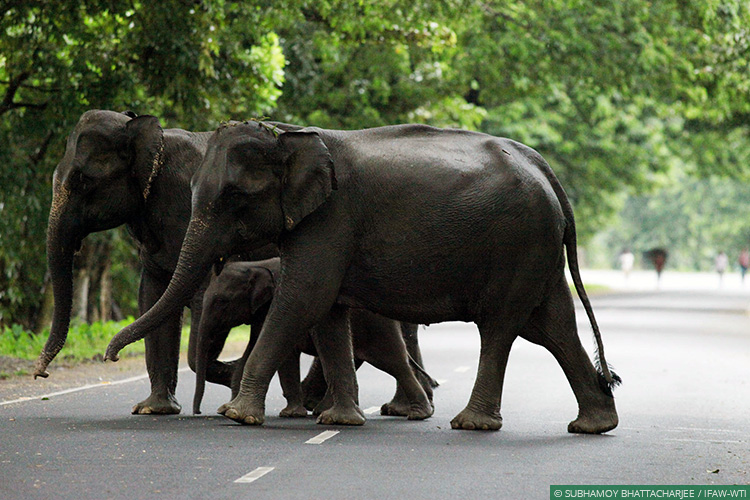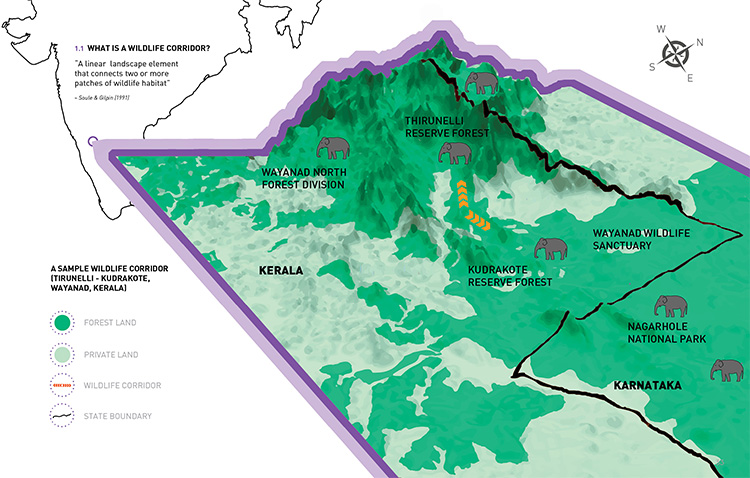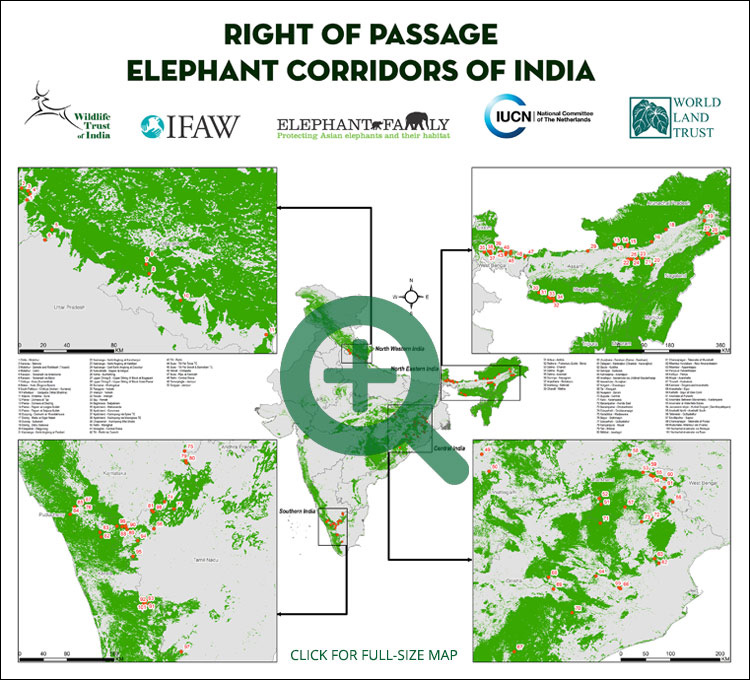PARTNERS: Project Elephant, IFAW, Elephant Family, World Land Trust, IUCN-NL
PROJECT LEAD: Upasana Ganguly (upasana@wti.org.in)
Despite being a figure of traditional cultural reverence, recognised indeed as the National Heritage Animal, and given the strictest level of protection under the law, the Asian elephant (Elephas maximus) is in a lot of trouble in India today. The crux of the problem is one that affects all wildlife in the country: land.
As India’s human population has grown exponentially in the past several decades, so has its demand for resources. At its essence, that demand boils down to the requirement for more land – for agriculture to grow more food, for roads, for dams and mines and railways and housing. This demand for land has led to the degradation and fragmentation of the country’s forest cover.
 Why did the elephant cross the road? Because we built one across its traditional migratory path, that’s why.
Why did the elephant cross the road? Because we built one across its traditional migratory path, that’s why.
Now the elephant, being a large herbivorous animal, needs vast areas to roam: browsing, foraging, moving from place to place in search of food and water with the changing seasons. The ‘home range’ of an elephant herd can vary from an average of about 250 sq km (in Rajaji National Park) to over 3500 sq km (in the highly degraded, fragmented landscapes of West Bengal). Research shows that the more forest habitat is degraded, the farther an elephant herd has to roam in search of food and water.
As elephants are forced to range farther and farther afield, this brings them into conflict with humans. And as humans encroach on forest areas, planting nutritious crops near forest lands, building homes and roads and railways, this invites conflict with elephants. Human Elephant Conflict is a very serious issue in India today: over 400 humans are killed in encounters with elephants annually, and crops and property worth millions of rupees are damaged. It is estimated in fact that elephants damage 0.8 to 1 million hectares of agricultural crops (Bist, 2002) every year, and assuming that an average family holds one or two hectares of land, Human Elephant Conflict can be said to affect at least 500,000 families!
Of course, there are also plenty of elephants killed in turn (about 1500 in the last 15 years) by human greed and indifference, and in retaliation for conflict: through train-hits, poaching for ivory, poisonings and electrocutions.
THE BIG SQUEEZE
India has by far the largest number of wild Asian elephants in the world, estimated at 27,312 according to the 2017 census, about 55% of the species’ global population. They range in 29 Elephant Reserves spread over 10 elephant landscapes in 14 states, covering about 65,814 sq km of forests in northeast, central, north-west and south India. But if that seems like a vast amount of territory, consider that Elephant Reserves include areas of human use and habitation – in fact unless they lie within existing Reserve Forests or the Protected Area network, Elephant Reserves are not legally protected habitats in themselves.
To have elephants in isolated populations, unable to move freely through their home ranges, would have a devastating effect on India’s natural heritage.
So a large chunk of the country’s elephant habitat is unprotected, susceptible to encroachment or already in use by humans. And while elephant populations are largely concentrated in protected forests in the north-eastern states, east-central India, the Himalayan foothills in the north, and the Western and Eastern Ghats in the south, the animals require free movement between these areas to maintain genetic flow and offset seasonal variations in the availability of forage and water.
That’s why ‘elephant corridors’ are so important. As forest lands continue to be lost, these relatively narrow, linear patches of vegetation form vital natural habitat linkages between larger forest patches. They allow elephants to move between secure habitats freely, without being disturbed by humans. In many cases, elephant corridors are also critical for other wildlife including India’s endangered National Animal, the Royal Bengal tiger (Panthera tigris).
WHY SHOULD WE CARE WHAT HAPPENS TO ELEPHANTS?
Well, because elephants are a keystone species. Their nomadic behaviour – the daily and seasonal migrations they make through their home ranges – is immensely important to the environment.
Landscape architects: Elephants create clearings in the forest as they move about, preventing the overgrowth of certain plant species and allowing space for the regeneration of others, which in turn provide sustenance to other herbivorous animals.
Seed dispersal: Elephants eat plants, fruits and seeds, releasing the seeds when they defecate in other places as they travel. This allows for the distribution of various plant species, which benefits biodiversity.
Nutrition: Elephant dung provides nourishment to plants and animals and acts as a breeding ground for insects.
Water providers: In times of drought they access water by digging holes, which benefits other wildlife. Further, their large footprints collect water when it rains, benefitting smaller creatures.
Food chain: Apex predators like tigers will sometimes hunt young elephants. Further, elephant carcasses provide food for other animals.
The umbrella effect: By preserving a large area for elephants to roam freely, one provides a suitable habitat for many other animal and plant species of an ecosystem.
To have elephants in isolated populations, unable to move freely through their home ranges, would therefore have a devastating effect on India’s natural heritage. Many animal species would suffer and the ecosystem balance of several wild habitats would be unalterably upset. It would also, of course, eventually lead to the local extinction of India’s National Heritage Animal, one of the wisest and most beloved species on the planet.
SECURING RIGHT OF PASSAGE






Elephant corridors are linear, narrow, natural habitat linkages that allow elephants to move between secure habitats without being disturbed by humans.
To secure a future for wild elephants it is essential that we ensure their uninterrupted movement between key habitats. And to do this, designated corridors must be legally secured and protected. This is what Wildlife Trust of India (WTI) has been working on through the Right of Passage project under its Wild Lands division for the last decade-and-a-half. Our aim, in partnership with the Government of India’s Project Elephant, the forest departments of elephant range states, and various non-governmental organisations, has been to protect and secure elephant corridors, while simultaneously rehabilitating (and improving the livelihoods of) people affected by conflict in corridor areas.
Over the years, WTI has evolved four approaches for securing and protecting elephant corridors in the country:
Corridor Securement: Success stories
Of the 101 corridors identified, six have been secured and six more are currently in the process of being secured through an amalgam of the four models.
| Secured corridors Thirunelli – Kudrakote, Kerala Edayarhalli – Doddasampige, Karnataka Kaniyanpura – Moyar corridor, Karnataka Siju – Rewak, Meghalaya Rewak – Emangre, Meghalaya Chilla – Motichur, Uttarakhand |
Corridors in the process of being secured Kalapahar – Daigrung, Karbi Anglong, Assam Chamrajnagar – Talamalai, Mudahalli, Karnataka Kaziranga – Karbi Anglong, Panbari, Assam Kaziranga – Karbi Anglong, Kanchanjuri, Assam Kaziranga – Karbi Anglong, Amguri, Assam Kaziranga – Karbi Anglong, Deosur, Assam |
 The 101 elephant corridors groundtruthed and mapped across India (click to view full-size)
The 101 elephant corridors groundtruthed and mapped across India (click to view full-size)
THE NEED TO UPSCALE
Although an extremely good beginning has been made thus far, with elephant corridors becoming a national policy initiative, all corridors across the country having been documented, and six corridors already having been secured, the rising tide of Human Elephant Conflict means that there is no time to be lost. We need to upscale our efforts to engage with both the government and corporate India and work concertedly towards our vision of securing all 101 elephant corridors.
The strategic direction for this includes: